
Acrotriche is a genus of about 18 species of flowering plants in the family Ericaceae, occurring in all states of Australia except the Northern Territory. Plants in the genus Acrotriche are shrubs with hairy branchlets, leaves with more or less parallel veins and small flowers with 5 sepals and petals joined at the base to form a bell-shaped to cylindrical tube with hairs and stamens in the throat.

Dampiera stricta commonly known as blue dampiera, is a flowering plant in the family Goodeniaceae. It is a small sub-shrub with variable leaves and mostly blue, mauve or purple flowers.

Trochocarpa is a genus of about 16 species of flowering plants in the family Ericaceae native to Australia, New Guinea, Borneo and Malesia. Plants in the genus Trochocarpa are shrubs or small trees, the leaves with more or less parallel veins, flowers in small clusters, each with 5 sepals, petals joined to form a cylindrical or bell-shaped tube, and the fruit a more or less spherical drupe.

Prostanthera ovalifolia, commonly known as the oval-leaf mintbush or purple mintbush, is a species of flowering plant in the family Lamiaceae and is endemic to south-eastern continental Australia. It is an erect shrub with egg-shaped leaves and groups of mauve to deep blue-purple flowers arranged in groups at the ends of branchlets.

Styphelia sieberi, commonly known as prickly beard-heath, is a species of flowering plant in the heath family Ericaceae and is endemic to south-eastern continental Australia. It is an erect, densely-branched shrub with oblong to more or less egg-shaped leaves with the narrower end towards the base, and white, tube-shaped flowers arranged singly in upper leaf axils.
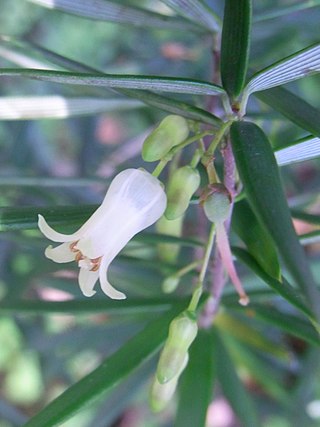
Lissanthe sapida, sometimes referred as the native cranberry, is a species of flowering plant in the family Ericaceae, and is endemic to areas near Sydney Australia. It is a bushy scrub with more or less lance-shaped leaves and creamy-white, cylindrical flowers.
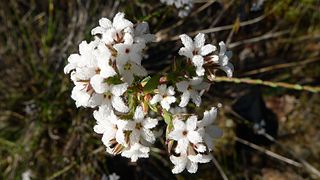
Leucopogon microphyllus is a species of flowering plant in the heath family Ericaceae and is endemic to eastern Australia. It is a bushy or spreading shrub with egg-shaped leaves, sometimes with the narrower end towards the base, and compact spikes of usually four to nine white, tube-shaped flowers.

Styphelia pendula is a species of flowering plant in the heath family Ericaceae and is endemic to the south-west of Western Australia. It is an erect, straggling shrub with oblong leaves and white, tube-shaped flowers that are bearded inside.
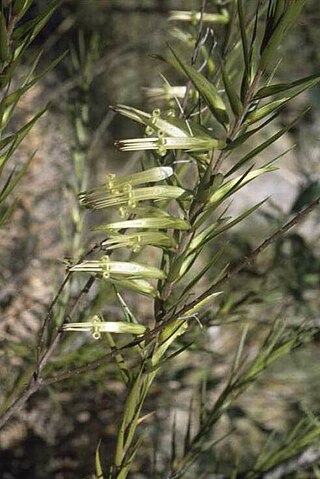
Styphelia longifolia, commonly known as long-leaf styphelia, is a species of flowering plant in the heath family Ericaceae and is endemic to New South Wales. It is an erect shrub with more or less lance-shaped leaves and pale green or yellow flowers arranged singly in leaf axils.
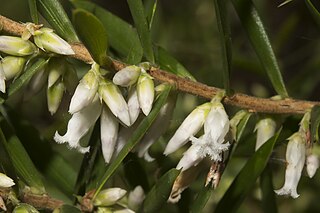
Styphelia propinqua is a species of flowering plant in the heath family Ericaceae and is endemic to the south-west of Western Australia. It is an erect, rigid shrub with linear leaves and white tube-shaped flowers that are bearded inside.

Leucopogon collinus, commonly known as fringed beard-heath, is a species of flowering plant in the heath family Ericaceae and is endemic to south-eastern Australia. It is a slender, erect or spreading shrub with narrowly lance-shaped leaves, and white, tube-shaped, bearded flowers.

Styphelia cuspidata is a species of flowering plant in the family Ericaceae and is endemic to the central Queensland coast. It is a shrub with densely hairy young branchlets, egg-shaped to lance-shaped leaves with the narrower end towards the base, and white, bell-shaped flowers that are bearded inside.

Epacris paludosa, commonly known as swamp heath, is a species of flowering plant from the heath family, Ericaceae, and is endemic to eastern Australia. It is an erect, bushy shrub with lance-shaped, elliptic or egg-shaped leaves and tube-shaped white or cream-coloured flowers in crowded, leafy heads at the ends of branches.

Styphelia deformis is a species of flowering plant in the heath family Ericaceae and is endemic to eastern coastal Australia. It is a bushy shrub with narrowly egg-shaped leaves, and white, tube-shaped flowers.
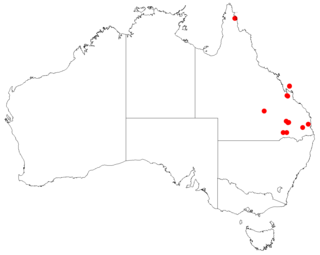
Styphelia imbricata is a species of flowering plant in the family Ericaceae and is endemic to south-east Queensland. It is an erect shrub with glabrous branches, crowded, often overlapping, egg-shaped leaves, and white, bell-shaped flowers that are bearded inside.
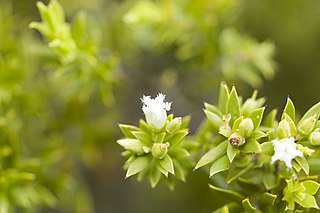
Styphelia leptospermoides is a species of flowering plant in the heath family Ericaceae and is endemic to eastern Australia. It is an erect, bushy shrub with elliptic to lance-shaped or oblong leaves, and white, tube-shaped flowers usually arranged singly in upper leaf axils.

Styphelia margarodes is a species of flowering plant in the heath family Ericaceae and is endemic to near-coastal areas of eastern Australia. It is an erect, spreading shrub with egg-shaped leaves with the narrower end towards the base, and small numbers of white, tube-shaped flowers usually arranged singly or in pairs in upper leaf axils.

Styphelia rotundifolia is a species of flowering plant in the heath family Ericaceae and is endemic to the south of Western Australia. It is an erect, bushy shrub with round or egg-shaped leaves, the narrower end towards the base, and white, tube-shaped flowers arranged in leaf axils in groups of 2 or 3.

Acrotriche serrulata, commonly known as honey pots, is a species of flowering plant in the family Ericaceae, and is endemic to south-eastern Australia. It is a low-lying, mat-forming shrub with lance-shaped to linear leaves, pale green to whitish, cylindrical flowers and greyish-green fruit.

Acrotriche aggregata, commonly known as red cluster heath, tall acrotriche or tall groundberry is a species of flowering plant in the family Ericaceae and is endemic to eastern Australia. It is an erect, spreading shrub, with elliptic to egg-shaped leaves, and spikes of tube-shaped, pale green, cream-coloured or white flowers, and succulent red drupes.




















